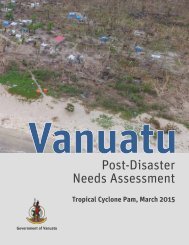Fiji
yqgk302EGjo
yqgk302EGjo
You also want an ePaper? Increase the reach of your titles
YUMPU automatically turns print PDFs into web optimized ePapers that Google loves.
FIJI Post-Disaster Needs Assessment<br />
Available literature was used to calculate the economic valuation of ecosystem services in the cyclone-affected area and,<br />
thus, estimate the damage and losses caused by TC Winston. The total value of damage to environmental assets is<br />
approximately F$233 million of which 51 percent is damage to coral reefs, 37 percent to native forests and 12 percent to<br />
mangroves. The total value of losses for these three environmental assets is approximately F$630 million. 110 Total recovery<br />
needs are around F$61 million, while reconstruction needs are approximately F$13 million.<br />
Environment Sector Background<br />
<strong>Fiji</strong> has a range of ecosystems, including seagrass beds, coral reefs, mangroves, wetlands, tropical forests and grasslands.<br />
Native forests, mangroves and coral reefs cover 1,423,280 hectares (ha) of land and coastal area.<br />
600000<br />
500000<br />
Assets in affected areas cyclone<br />
Assets in non affected areas<br />
400000<br />
Hectares<br />
300000<br />
200000<br />
100000<br />
0<br />
Native Forest<br />
Figure 31: Hectares of Assets in Affected Areas<br />
Source: Estimations by Assessment Team.<br />
Mangrove<br />
Assest Type<br />
Coral reefs<br />
Native Forests cover about 969,050 ha of land, of which 47 percent is in cyclone-affected provinces. Only a small<br />
percentage (approximately 2.7 percent or 43,000 ha) is currently in protected areas with another 57,000 ha proposed for<br />
conservation/protection (National Environment Council-IP Report; Olson et al., 2010; <strong>Fiji</strong> Biodiversity Strategy and Action<br />
Plan, 2007). Dry forests are among the most critically endangered forest types. Multiple pressures have degraded the<br />
condition of forests, including illegal logging, unsustainable harvesting of timber by traditional landholders, clearance for<br />
agriculture, collection of firewood, and invasive vine and tree species, particularly African tulip.<br />
Mangroves cover 54,190 ha of coastal areas, of which 67 percent are in cyclone-affected provinces. The major pressures<br />
on mangrove forests are illegal logging and fuelwood collection, which led to around a 25 percent loss of total mangrove<br />
area from 2003 to 2013 (MACBIO, 2016).<br />
Coral Reefs cover approximately 454,000 ha of nearshore and marine areas in <strong>Fiji</strong>. Of these, almost 80 percent is within<br />
a 50km radius from the cyclone’s path. Almost 17 percent of coral reefs are under conservation and local protection, an<br />
increase from 12 percent in 2010. This resulted from the decision by local communities to establish the <strong>Fiji</strong> Locally Managed<br />
Marine Area.<br />
Assessment of Disaster Effects on the Environment (F$862 million)<br />
The combined damage and losses for the environment sector amount to F$862 million, of which F$233 million is attributable<br />
to damage, F$595 million are losses from ecosystem assets and F$34 million is attributable to losses generated by waste<br />
management requirements following TC Winston.<br />
Damage to the Environment (F$232 million)<br />
For native forests and mangroves, damage included fallen trees and extensive loss of foliage stripped by the cyclone. For<br />
coral reefs, damage included uprooting of hard corals, and extensive death of fish and other marine life (see Box 1). Total<br />
damage is F$232 million, with the majority of this attributable to coral reef damage.<br />
110<br />
This figure includes a recovery timeframe that is aligned with the recovery periods considered for other sectors within this PDNA.<br />
However, the recovery period for the environment sector could stretch to 10 years for coral reefs and 15 years for native forests and<br />
mangroves; therefore, total losses may be higher than those reflected in this report.<br />
96 Tropical Cyclone Winston, February 20, 2016



